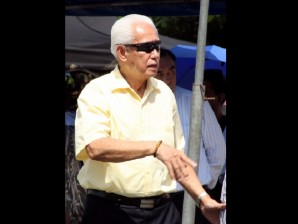
Manila Mayor Alfredo Lim. INQUIRER FILE PHOTO
MANILA, Philippines — An offhand remark about hundreds of unrecognized and unidentified Katipuneros executed in Bagumbayan (now Luneta Park) in a meeting between Manila Mayor Alfredo Lim and officials of the National Parks Development Committee (NPDC) led to the building of a memorial path of the forgotten martyrs at the national park.
Sunday morning’s inauguration of the Pathway to Glory at the Heroes’ Square of the Luneta Park became the centerpiece of the 441st founding anniversary of Manila, considered the seedbed of the country’s independence.
The concrete path winding through the 2,500-square meter area, previously the Chess Plaza, is lined with 50 black granite tablets bearing the names of the Katipuneros executed during the Spanish colonial era at the same site. The National Historical Commission of the Philippines (NHCP) estimates that 800 revolutionary martyrs were executed in Bagumbayan, including the priests Jose Burgos, Jacinto Zamora, and Mariano Gomes or collectively known as Gomburza.
Of the 50 tablets, only 20 have been filled with the names of the 73 executed Katipuneros who have, so far, been identified by the NHCP. The agency is still working to fill up the 33 blank granite tablets with names of the other martyrs.
The memorial walk was practically Lim’s brainchild, NPDC communications and media bureau chief Kenneth Montegrande told the Philippine Daily Inquirer, pointing out that the idea was from a comment made by Manila Mayor Lim during one of the events at the park three months ago.
Lim, he revealed, had told NPDC executive director Juliet Villegas that apart from the national hero Jose Rizal, there were so many other revolutionaries, including Gomburza and Trece Martires (Thirteen Martyrs), who were executed in Bagumbayan and who should be recognized and remembered.
Thus the path of remembrance was born. The NPDC, continually working to restore Luneta Park into its status as the national park, adapted the concept and coordinated with the NHCP, the Intramuros Administration (IA) as well as the Tourism Infrastructure and Enterprise Zone Authority (TIEZA) to search for the identities of the Bagumbayan martyrs.
In Sunday’s inauguration of the Pathway to Glory, which was timed with Araw ng Maynila, Lim was invited as the guest of honor and was bestowed the honor of cutting the ribbon to officially open the area to the public along with Villegas, IA administrator Jose Capistrano, and NHCP executive director Ludovico Badoy.
The path where the Katipuneros are being honored was the same spot where they were executed one and a half centuries ago.
Lim, in his speech, said in Filipino, “This is the same sacred ground watered by the blood of our heroes fighting for our freedom.” He expressed gratitude to Villegas for preserving the sanctity of the site and for enabling thousands of park visitors a feel of the country’s history.
He pointed out that almost all Filipinos were aware of Rizal’s execution at Bagumbayan. “But there were so many others who were executed here fighting for our independence. Hundreds of Katipuneros, including Gomburza and Trece Martires.”
He encouraged students around Manila to explore the pathway and ponder on the sacrifice of the Katipuneros that won for us our freedom.
Montegrande told the Inquirer, “The Pathway to Glory memorial is a walk of remembrance that is seen as a source of intellectual and spiritual upliftment among park visitors, both Filipinos and foreigners. It is envisioned that this public art will provide a sense of historical continuity in Rizal Park as present day park visitors will be made aware of what transpired in this hallowed ground.”
He added, “It will also serve as a continuing reminder for Filipinos that what we enjoy today are the fruits of our forefathers’ courage, sacrifice and love for the country.”